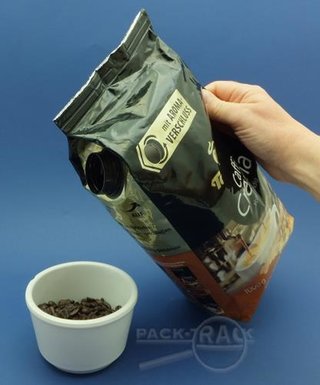Image courtesy of funnyangel/Shutterstock
NEWS
A Surprisingly Clever Innovation for Coffee Lovers
Innovations make life easier, especially in the world of consumer product packaging. There are some groundbreaking solutions changing people's habits and lifestyles but also many little improvements, sometimes unexpected, that simply introduce convenience to consumers' daily routines. Global Data takes a look at how Tchibo’s new pack design for Caffe Crema Vollmundig coffee is improving on the standard coffee bag
The full-bodied Arabica coffee beans come in a – rather standard in the sector – foil/plastic bag with side gussets and a freshness valve sealed to the inside of its front face. At first glance, the pack looks rather typical and is no different from those of other coffees on the market. What makes the difference, however, is the application of a plastic spout set into the top of one of the side gussets. The spout is closed with a screw cap that has fine grip ridges around the sides and a narrow auto-break tamper band around the base.
The addition of a resealable screw cap is highly unusual on a side-gusseted flexible bag.
An internal section is pushed downwards as the cap is unscrewed, cutting a hole in the bag film. While the spouted closure provides the consumer with good directional control when pouring out the beans and reduces the incidence of product spillages, the screw cap creates an intuitive and easy means of opening and closing the pack and eliminates the need for scissors. There is no need for additional reclose devices such as a clip or elastic band or for transferring the beans to a storage container to maintain freshness.

Image courtesy of GlobalData
"The 'patented' closure is similar to caps used on liquid cartons," comments Pawel Urban, packaging analyst for GlobalData. "The addition of a resealable screw cap is highly unusual on a side-gusseted flexible bag. It also provides an airtight seal to prevent the beans coming into contact with oxygen so that they remain fresh and flavorsome for several months."
The full-bodied Arabica coffee beans come in a – rather standard in the sector – foil/plastic bag with side gussets and a freshness valve sealed to the inside of its front face. At first glance, the pack looks rather typical and is no different from those of other coffees on the market. What makes the difference, however, is the application of a plastic spout set into the top of one of the side gussets. The spout is closed with a screw cap that has fine grip ridges around the sides and a narrow auto-break tamper band around the base.
The addition of a resealable screw cap is highly unusual on a side-gusseted flexible bag.
An internal section is pushed downwards as the cap is unscrewed, cutting a hole in the bag film. While the spouted closure provides the consumer with good directional control when pouring out the beans and reduces the incidence of product spillages, the screw cap creates an intuitive and easy means of opening and closing the pack and eliminates the need for scissors. There is no need for additional reclose devices such as a clip or elastic band or for transferring the beans to a storage container to maintain freshness.

Image courtesy of Someone ??????????
"The 'patented' closure is similar to caps used on liquid cartons," comments Pawel Urban, packaging analyst for GlobalData. "The addition of a resealable screw cap is highly unusual on a side-gusseted flexible bag. It also provides an airtight seal to prevent the beans coming into contact with oxygen so that they remain fresh and flavorsome for several months."
"The 'patented' closure is similar to caps used on liquid cartons," comments Pawel Urban, packaging analyst for GlobalData. "The addition of a resealable screw cap is highly unusual on a side-gusseted flexible bag.
It also provides an airtight seal to prevent the beans coming into contact with oxygen so that they remain fresh and flavorsome for several months."
Image courtesy of funnyangel/Shutterstock.com